Prevent Slips and Floor Damage With the Right Rug Pad
http://decor-ideas.org 12/04/2014 22:13 Decor Ideas
Choosing a rug is an important decision. Its style, shape, size, color and texture can make or break a room. But while the rug steals the spotlight, something less glamorous also deserves special consideration: the rug pad.
For most people a rug pad is an afterthought. But it’s actually an important accompaniment to your rug. It ensures that no one will slip, and it protects the rug and floors from damage. Not all rug pads are created equal. Here’s what you need to know about choosing the right one for your home.
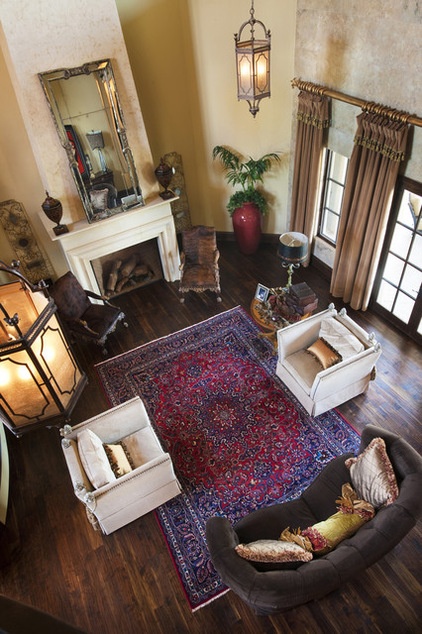
Rug pads are made of different materials, and come in different thicknesses and sizes, for different kinds and sizes of rugs. Some are better for hard floors, and others work better on carpet.
Safety. Whether you have an intricate, handwoven piece of valuable artwork, like the rug shown here, or something simple, your rug needs to stay in place to prevent slipping, tripping and, in the worst case, injury. A rug pad acts as a grip by holding the rug flat against the floor to prevent sliding. It also keeps it from curling and bunching, which can create tripping hazards. Without a rug pad, some area rugs will “creep” along a floor over time (even if they have furniture on top), moving off-center.
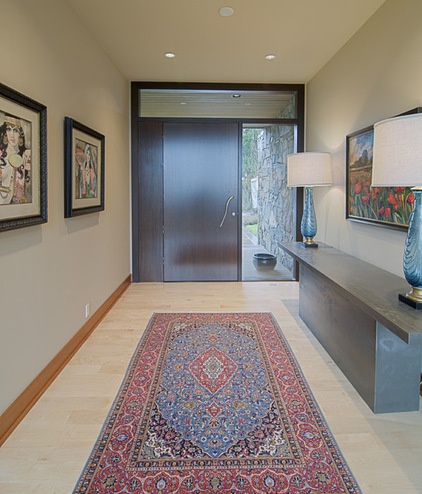
Preventing rug damage. A rug pad will help your area rug last longer too. By keeping the rug in place, it prevents the fibers on the back of the rug from being agitated and wearing against flooring materials.
A rug pad also prevents premature wear by acting as a shock absorber for foot traffic, especially in high-traffic areas, like this entryway. The density of the pad preserves the pile of the rug and helps the fibers spring back into position after being walked on, preventing premature flattening of the rug pile.
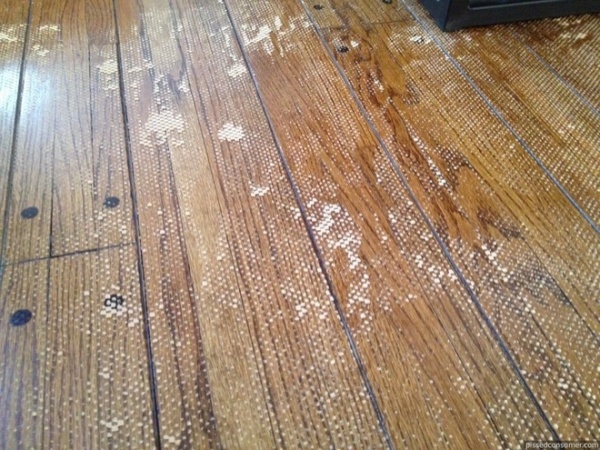
Preventing floor damage. The wrong rug pad can actually damage your floors. And because rug pads aren’t frequently moved (or even looked at), the damage can go long unnoticed.
Vinyls include a large group of plastics, including PVC (polyvinyl chloride). Many lower-cost rug pads, most coming from overseas, are made of PVC. Because PVC is made from petroleum-based chemicals and isn’t a breathable material, it’s unable to absorb or release moisture. It “sweats” against the flooring material and can damage the finish, as in the image shown here. Residue from the chemicals added for “grippiness” also transfers to the floor finish.
It’s best to avoid vinyl and PVC rug pads altogether. The cost to refinish or replace damaged flooring will far outweigh the comparatively minute cost savings from the rug pad.
Latex is a natural material that comes from trees. The composition of latex differs from plant to plant, but natural rubber, the best-known type of latex, is a good rug pad material for wood floors (more about this later).
However, rubber and synthetic latex, also known as SBR (styrene-butadiene) are frequently mixed with clay fillers as a way to reduce material costs. The clay in the rug pad breaks down into a powdery mess after one to three years. Avoid rug pads made of synthetic latex or any latex other than 100 percent rubber.
Chemicals added to small rugs with an integral nonskid backing — like those frequently used in kitchens and bathrooms — to help them stay flexible also react with flooring finishes and cause them to yellow, especially vinyl flooring.
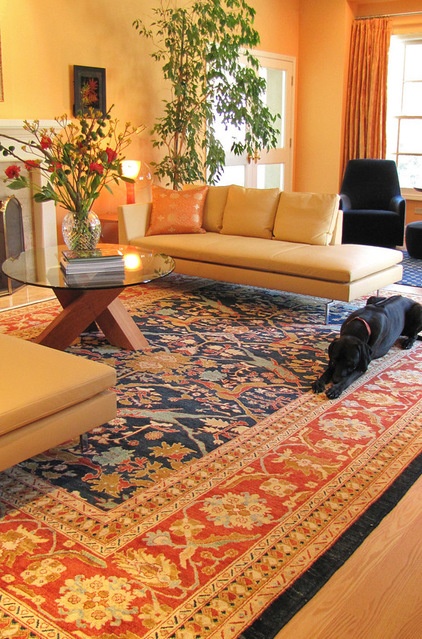
Where to Start
First evaluate your area rug’s size, weave and thickness. This will help determine which rug pad material is appropriate. The quantity of rug pads on the market is almost dizzying, and it’s easy to become overwhelmed. Here’s a brief guide.
Small rugs: For 3-foot by 5-foot and smaller rugs, a thin, nonskid rug pad is recommended. This is especially true if the rug is in a high-traffic area. A thinner rug pad is ideal to prevent a sudden and brief height change that can pose a tripping hazard.
Large rugs: Any rug that’s 8 feet by 10 feet or larger and not prone to slipping may be fine with a rug pad that doesn’t have a nonskid component to it, such as a felt pad. The felt will protect the floor and assist in keeping the rug in place. Usually a ¼-inch or ⅜-inch pad is adequate. Some people who like extra cushioning go for a ½-inch-thick pad, but that thickness borders on a bit too much.
Thin rugs: Flat-weave rugs, such as kilims, don’t typically lay flat; they tend to curl at the corners. Thin rugs will do best with a rug pad that’s a combination of felt and rubber combination, either ⅛ or ¼ inch thick, depending on how much cushioning you want.
Thick rugs: Heftier rugs, such as plush Orientals, will do well with a ¼-inch- or ⅜-inch-thick rug pad. If a rug is thick (½ inch or greater), then a too-thick rug pad may be overkill and can be a tripping hazard due to the level change between floor and rug.
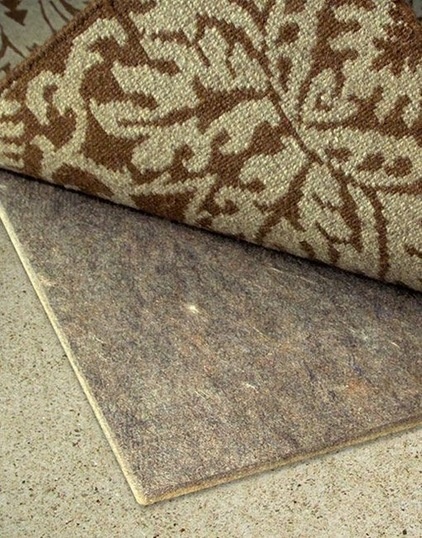
Choosing a Material
As discussed earlier, synthetic materials should be avoided. Sam Kaoud, principal of Rug Pad Corner, says the best rug pads are made from natural materials. Recycled felt and 100 percent natural rubber are the most prevalent, but wool is also a good option. Kaoud notes that besides providing protection for the floor, rubber and felt are dense and offer crucial stability for the rug. Natural materials won’t damage the finish of your floor, no matter if it’s hardwood, vinyl, tile or carpet.
Most natural rug pad products are American made, and many suppliers have environmental certifications, such as by the U.S. Green Building Council or Rug Pad Retailers of America, that validate origin and material claims, so you know what you’re buying. The pad shown here, called Superior, is made from 100 percent recycled felt jute and has a Green Label certification from the Carpet and Rug Institute for indoor air quality.
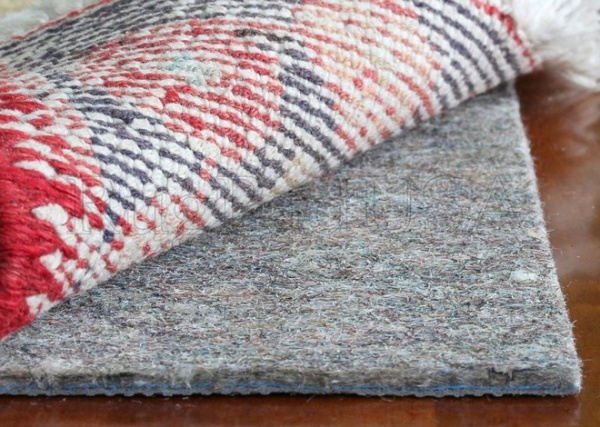
Felt and rubber. Felt pads are especially popular to use with Oriental area rugs. They provide a luxurious feeling underfoot and offer thermal- and sound-insulation benefits.
However, despite providing protection for both the floor and rug, felt rug pads do not altogether prevent unwanted movement. To compensate and bring together the best of both worlds, many manufacturers combine felt and rubber in one pad, as seen here. The rubber creates the nonslip benefit not present in felt alone.
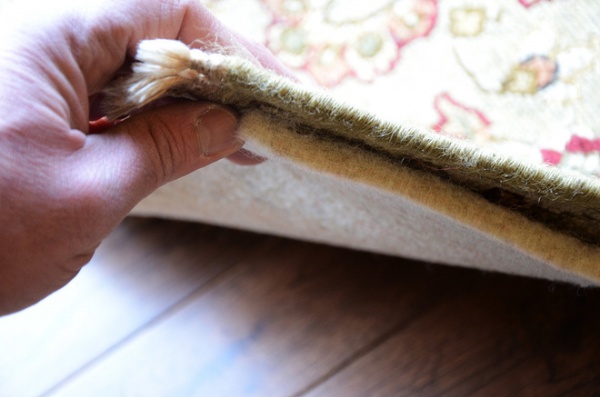
Wool. For folks who have allergies to latex products, a wool rug pad is a good alternative. It’s a biodegradable, renewable, sustainable resource. Wool is also inherently flame retardant and thermally and acoustically insulating. However, wool may pose a problem for people with airborne allergies.
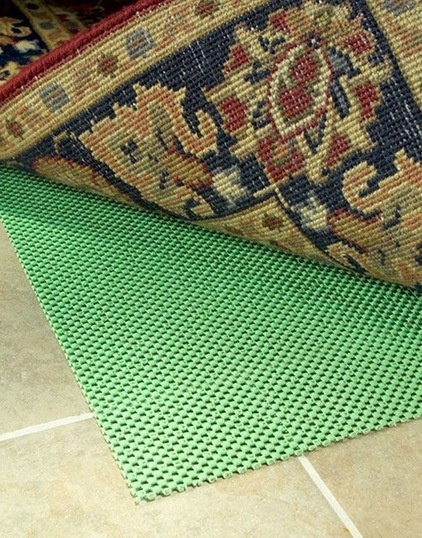
Nonskid PVC alternatives. Made entirely of natural rubber, this rug pad is ideal for situations where you want a nonskid pad but have limited height clearance, such as for a door-swing area. However, the thinness of this pad means it doesn’t offer insulation or cushioning.
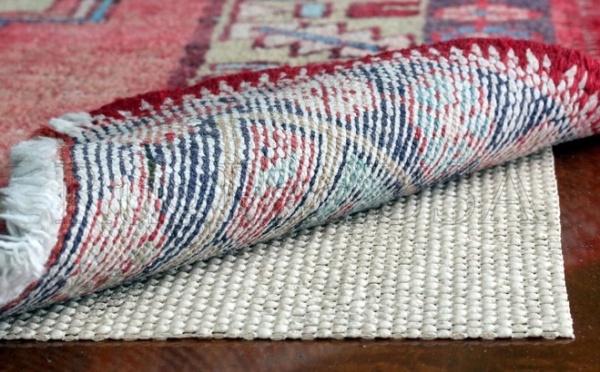
Another nonskid alternative to rubber is a rug pad made from soybean oil instead of petroleum-based PVC.
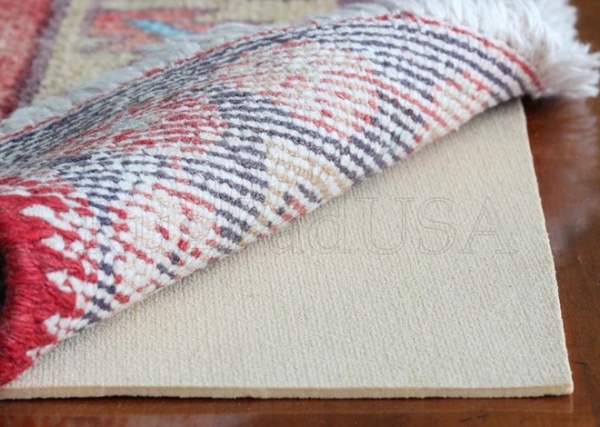
A solid natural rubber pad like this one is ideal for situations where some cushioning and the stay-put power of rubber is required. However, compared with the felt and rubber combination, a solid rubber pad doesn’t offer as much insulation.
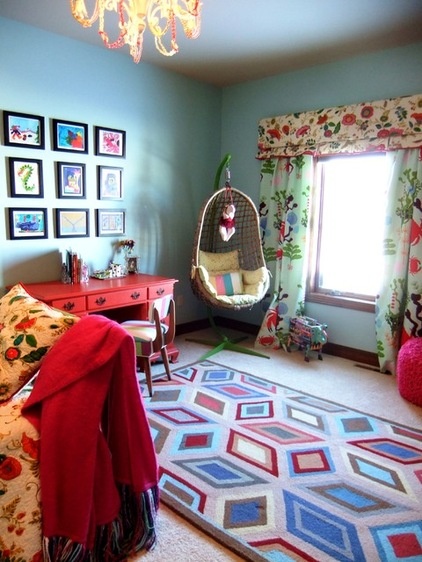
Pads for rugs on carpeting. Rugs are a great way to break up a large expanse of wall-to-wall carpeting and create zones that ground a space, like in this bedroom. But a rug on carpet can also shift. That’s why a rug-to-rug pad is needed.
8 Tips for Layering Rugs
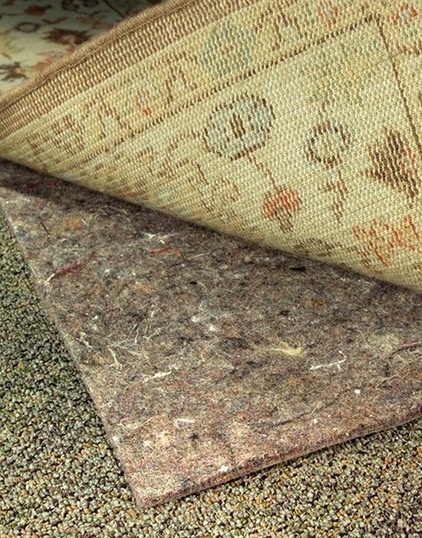
An area rug on top of carpeting needs an extremely dense rug pad to prevent the weight of furniture and foot traffic from sinking into the pile of carpeting and causing wrinkling. At a dense 50-ounce weight, this No-Muv rug pad absorbs pressure and prevents indentation and wrinkling in the carpeting. The No-Muv pad is ¼ inch thick and made entirely of recycled felt.
No-Muv pads also have a distinct texture on the lower felt surface that allows them to effectively grab the carpeting underneath to prevent slipping and shifting.
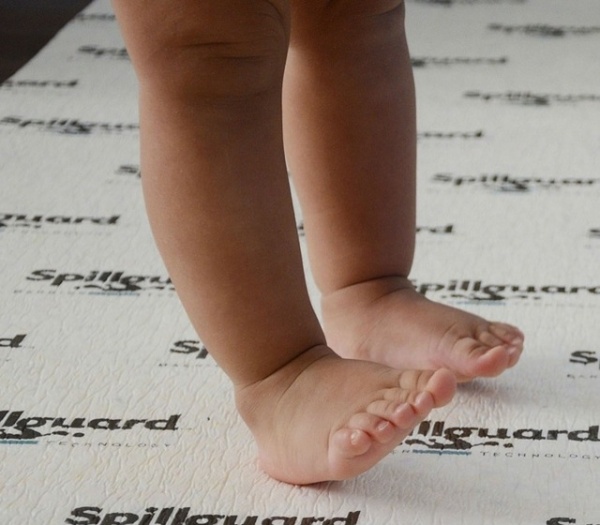
Spill-resistant rug pads. No one wants to think about spills on their area rugs, but it’s likely to happen, especially if you have little ones running around. A spill-resistant rug pad will prevent the moisture from soaking through and possibly ruining your flooring. This example has a moisture barrier made by DuPont and comes in ¼-inch and ⅜-inch thicknesses and has the usual benefits of a thicker pad, such as insulation and noise reduction.
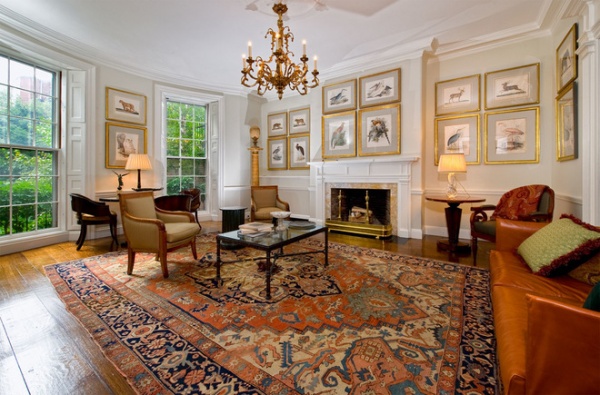
Rug pad sizes. Most types of rug pads should be about 1 inch smaller on all sides than the rug size to allow the edges of the rug to relax to the floor, Kaoud says. Many companies will custom cut pads to fit the area rug, including in oval, circle and odd shapes.
Most rug pads are available in widths up to 12 feet. For area rugs with a width larger than 12 feet, some companies secure two pieces together with carpet tape.
Rug pad maintenance. The best way to clean a rug pad is by sponging or carefully brushing it with a scrub brush and water and a mild liquid detergent. Expect a quality rug pad to last about 15 years.
Cost. A quality felt or rubber rug pad will cost about $1.75 per square foot. By comparison a low-quality PVC-type pad runs about 50 cents per square foot.
More:
How to Choose an Awesome Area Rug No Matter What Your Space
12 Ways to Work With Rugs for Warmth and Beauty
Related Articles Recommended












